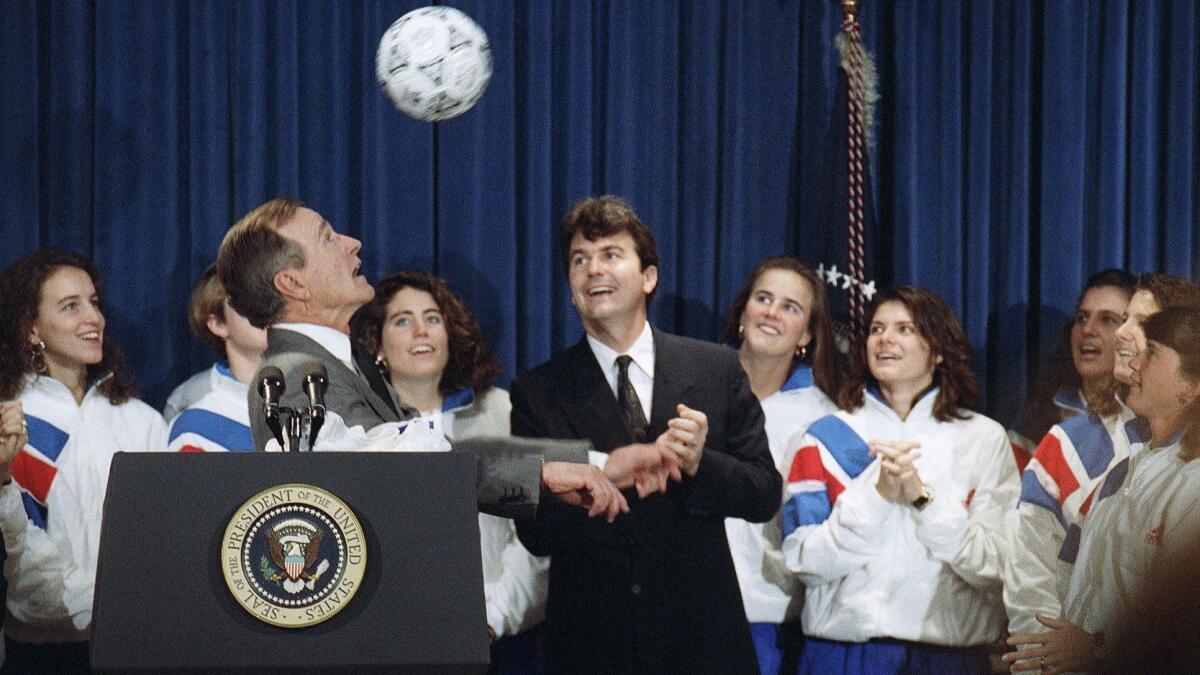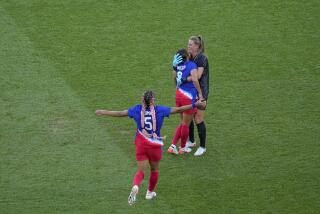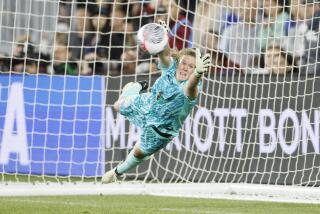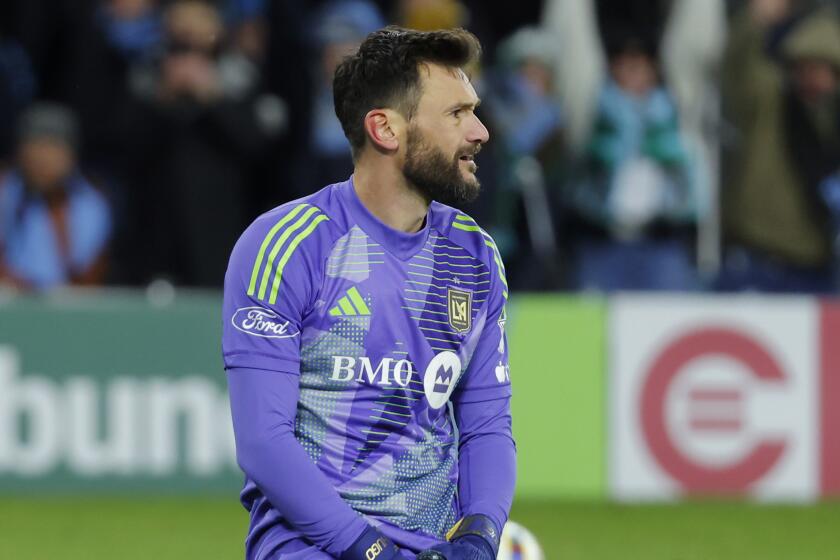Newsletter: Soccer! Women’s World Cup has come a long way from shaky beginnings

Hello and welcome to the latest edition of the L.A. Times soccer newsletter. I’m Kevin Baxter, the Times’ soccer writer. By the time you’re reading this I’ll be (fingers crossed!) in Paris preparing for Friday’s Women’s World Cup opener between France and South Korea.
This will be the eighth edition of the Women’s World Cup, a tournament with such humble beginnings that it’s truly a wonder it survived. The tournament was born in China in 1991 and officially began life as the “1st FIFA World Championship for Women’s Football for the M&M’s Cup.”
And if you think that’s a mouthful, try saying it with chocolate in your mouth.
The insults didn’t end there, though. In those days the U.S. team stayed in roach-infested motels and got by on a $10-a-day per diem. Or didn’t get by, depending on your point of view.
“We just existed on warm Pepsi and Mars bars because that was a sponsor and Pepsi was a sponsor,” said Julie Foudy, a member of that team.
Games ended after 80 minutes instead of the regulation 90 for a men’s match, apparently because organizers feared a full-length match would tax the gentle constitutions of the women – probably because they had been eating all that chocolate.
April Heinrichs, captain of the victorious U.S. team, offered another theory.
“They were afraid our ovaries were going to fall out if we played 90,” she said.
The competition was, shall we say, uneven. Even with the shortened matches, Michelle Akers scored a record five goals in a 7-0 U.S. win over Taiwan in the quarterfinals. Akers scored twice more in the final and finished the tournament with 10 goals.
Both records still stand.
Four years later the tournament moved to Sweden and got a proper name – not that anyone noticed. Just 250 people showed up at a minor-league venue for a group-play game between Canada and Nigeria.
“To everyone outside of friends and family and the players themselves, it was like a tree falling in the woods that nobody sees or hears,” Briana Scurry, the U.S. goalkeeper, said of that World Cup. “It happened. But nobody saw or heard it.”
All that changed 20 years ago this month. When the tournament came to the U.S. in 1999, organizers courageously resisted the pleas of FIFA and others to think small. They were told they were crazy to schedule games in massive NFL stadiums when so many perfectly good junior college facilities were available.
So the U.S. players weren’t the only ones surprised when the team bus got caught in a massive traffic jam on the New Jersey Turnpike heading to Giants Stadium, which was sold out for the opener.
“We had no expectation,” said Brandi Chastain, who would make her own World Cup history in the final three weeks later. “It was like ‘Holy cow! We’ve got traffic!’ “
There was a sense that the Women’s World Cup hadn’t just arrived, but it had moved in and set up housekeeping. That was confirmed when more than 90,000 – still the largest crowd to watch a women’s match -- jammed the Rose Bowl on a sweltering July day to see the U.S. beat China on Chastain’s penalty kick, a victory she celebrated by partially disrobing. (You can watch the entire round of penalty kicks by clicking here).
“It became this iconic event. And I think it represented all the possibilities in the belief we had,” said Mia Hamm, the star of that ’99 championship team. “Not just our game, but in women’s sports in general--when you put the funding and the marketing, and you invest in, you know, the game, and the team, and promoting it, what can happen.”
In 2007, FIFA added a prize-money purse. This year that purse will grow to $30 million to be shared among the 24 teams – paltry compared to $38 million FIFA gave France alone for winning the men’s World Cup last summer but a big step up from $10 per diems and warm Pepsi.
Gone, too, are the days when the U.S. could simply roll the ball out and win the tournament. This year’s 24-team is unquestionably the deepest and most talented ever for a women’s tournament. And while the top-ranked Americans, the defending champions, come in as the favorites, as many as a half-dozen teams have good reason to think they can win.
One of those teams is France, the host nation and the only team to beat the U.S. in the last 23 months. In the tournament goes to form, France could face the Americans again in the quarterfinals before a crowd of more than 50,000 in Paris.
“Every four years the competition gets stiffer and stiffer just because that gap closes,” said Kelley O’Hara, a defender on the current U.S. team. “There’s going to be a lot of teams that I think will surprise some people. And that’s what makes the World Cup exciting.”
Their cup already runneth over
The Galaxy are one of four MLS teams chosen to play in a new eight-team summer tournament, the Leagues Cup, launched jointly last week by MLS and Mexico’s Liga MX. We should probably reserve judgment on the event until, you know, they actually play a game.
But it’s hard not to immediately dump this one into the basket reserved for second-tier competitions no one takes seriously.
Consider just the Galaxy’s situation. The team is scheduled to open the tournament July 23 against Tijuana at Dignity Health Sports Park. That’s four days after the first El Trafico with LAFC and four days before what figures to be a crucial Western Conference showdown with the Timbers in Portland.
What are the chances that Zlatan Ibrahimovic, at 37, the oldest outfield player in MLS, plays three games in eight days? Ditto Jonathan dos Santos, the team’s most important player, who is already limping with leg and hip issues. If you’re coach Guillermo Barros Schelotto, which game do you hold them out of?
If the Galaxy advance to the Leagues Cup semifinals they would play again Aug. 20, in between games with Seattle and LAFC – again, both crucial matches in terms of playoff positioning. The Cup game would also leave the team playing five games in two weeks, beginning with a cross-country trip to D.C. United.
And if the Galaxy make a deep run into the U.S. Open Cup – a far more important event – the semifinals and final of that tournament are scheduled for August as well. That could mean eight games in 25 days.
So let’s set aside the hype coming from both sides of the border and pull the curtains back on the Leagues Cup to expose it for what it is: a flimsy attempt to wring more money out of the players.
Organizers say this is another opportunity to showcase the talent in the two leagues by matching the best teams. The Liga MX stepped up by choosing reigning champion America and Tigres, the reigning Campeones Cup winner, along with Cruz Azul and Tijuana. MLS will be represented by the Galaxy, Houston Dynamo, Chicago Fire and Real Salt Lake, four teams that combined for 59 losses and one playoff win last season.
Houston, Chicago and the Galaxy do share one other thing besides the lack of a 2018 playoff berth: They all play in cities with huge Mexican populations.
What’s more we already have a real cross-border tournament. Although the CONCACAF Champions League is, in theory, open to club teams from throughout the confederation, in reality it’s an MLS-Liga competition with invited guests, who typically leave early.
No other league has been represented in the final of the CCL since 2009 and no league other than the Liga MX has won it since 2005. MLS has long argued that the tournament is not a fair indicator of its teams’ strength because games are played during the MLS preseason while Liga MX teams are already playing regular-season league matches.
Well the Leagues Cup isn’t likely to measure the relative strengths of the team since the Galaxy – and other teams, we presume -- will most likely use lineups sprinkled with USL players and other reserves.
And finally if this is not a blind money grab but a legitimate, competitive tournament, why are all the games being played in the U.S., denying the Mexican teams a home-field advantage and denying their fans a rare chance to see MLS players like Ibrahimovic, Dos Santos and Bastian Schweinsteiger?
Well, because organizers can charge more for tickets and sponsorships in the U.S.
We’ve seen this before. MLS and Liga MX teams used to play in something called the Superliga, an eight-team tournament played entirely in the U.S. during the heart of the MLS season. Sound familiar?
It wasn’t so super, which is why it was discontinued in 2010 after four editions. The last final was watched by less than 11,000 people in a 65,000-seat NFL stadium.
LAFC: If you can’t beat ‘em…well, beat them
Wherever your MLS allegiance lies – and loyalties in Southern California are split between two teams – it’s far past time to acknowledge LAFC is accomplishing something special in just its second year.
Saturday’s 3-2 win in Portland not only spoiled the reopening of Providence Park and ended the Timbers’ 15-match winning streak in home openers, it also extended several positive streaks for LAFC.
Nearing the midway point of the season Bob Bradley’s team:
--Is unbeaten in eight games dating to mid April, the longest streak in the Western Conference
--Is a league-best 4-1-3 on the road
--Is unbeaten in its last 14 games at home, the longest streak in the league
--Leads MLS in goals (39), points (37) and wins (11)
--Has allowed the second-fewest goals in the league (13), giving it a ridiculous goal differential of +26; no other team is even in double digits
Meanwhile Carlos Vela, who had a goal, his 16th, and an assist, his 10th, leads MLS in both categories. He is not only on pace to destroy the league single-season scoring record but also to become the first player in MLS league history to finish a year with at least 20 goals and 20 assists.
Add it all up and it’s shaping up to be the greatest season, both collectively and individually, in league history.
“I think it’s a little too early to say that,” forward Christian Ramirez said with a chuckle. “We have bigger goals in mind. We want to win trophies. And once we win some trophies, then you can start to talk about that.”
Added midfielder Latif Blessing: “So far so good. We take it game by game and our dream is to win MLS Cup.”
There is a negative side to the dominance however. LAFC’s attractive, possession-based playing style is so unstoppable, opponents have become more and more aggressive in trying to at least slow the team down. And Vela, more often than not, has paid the price for that.
The Portland game featured 27 fouls, eight against Vela, extending another category in which LAFC leads MLS: fouls suffered, with an average of more than 14 a game. Individually, only Seattle’s Nicolas Lodeiro has been fouled more often than Vela. Blessing is just one foul behind.
And the challenges have become more and more punishing. Vela told Bradley he felt lucky to avoid a broken leg in recent wins over Columbus and Dallas.
“We’re not naive,” Bradley said after the Portland game. “There’s going to be physical games. But I don’t like to see it get to the point where it got in the second half.”
With opponents often turning his team’s beautiful game into a pier six brawl, it may be time for referees to step in and take control before a magical season for Vela, LAFC and the league as a whole is carried off the field on a stretcher.
“When’s the last time you saw [Lionel] Messi get mauled the way Carlos got mauled?” Bradley asked.
Galaxy: ‘Maybe this is who we, are to be realistic’
The Galaxy locker room was quiet and mostly empty after Sunday’s underwhelming loss to the lowly New England Revolution.
Rolf Feltscher, who didn’t play, and Diego Polenta, whose last-second shot nearly tied the score, both left before the room opened to the media, exiting down a darkened hallway to avoid fans in the Champions Lounge. Few of the teammates they left behind were more accountable after the team’s third consecutive home loss – and the second straight to a team that had not won a road game previously.
Ibrahimovic spoke, as he always does. So did Dos Santos. But goalkeeper David Bingham, who let New England’s first goal slip through his hands, declined. A couple of other players spoke to the Galaxy’s broadcast partner and two more spoke to a reporter about the Gay Pride Night celebration.
But with the exception of Ibrahimovic and Dos Santos, the team’s two captains, no one stepped forward to answer the hard questions or to explain what has happened to a team that was the league’s best April but is 2-5-0 since.
Even a visibly disappointed Schelotto, the team’s coach, had little to say, ending his postgame media conference after taking just a handful of questions.
“It was not a difficult game. I think everybody was underperforming,” said Ibrahimovic, who scored the team’s only goal on a marvelous bicycle kick in the 84th minute. “We were playing at home and I felt that we were dominating in the beginning, but we let them play and come into the game.
“We should have won. No excuses.”
(You can watch Zlatan’s bicycle-kick goal by clicking here.)
Maybe that’s why no one spoke, there was nothing much to say. How can anyone explain a team that has dominated top clubs like Philadelphia, Houston and Portland only to lose to bottom-feeders like Colorado and New England?
“Maybe this is who we are, to be realistic,” Ibrahimovic said. “We have ups and downs and reality will catch you sooner or later. We just have to do our best and fight for it.”
The Galaxy had the ball for nearly an hour Sunday yet were outshot and put just two tries on target, both by Ibrahimovic, whose goal was his 11th of the season.
The three-week Gold Cup break may be coming at a good time for the Galaxy, who lost midfielder Romain Alessandrini to knee surgery in April, were without Feltscher for a second straight game Sunday, then saw Sebastian Lletget (hamstring) and Uriel Antuna (shoulder) leave with injuries.
Despite the injuries and inconsistency, the team is second to LAFC in both the Western Conference and Supporters’ Shield standings, leaving them well-positioned to make a second-half run at a top seed for the MLS playoffs. Dos Santos, who has been battled aches and pains of his own, seems eager to hit the reset button.
“It’s frustrating having these streaks where you’re winning, then losing and then winning and then losing again and again,” Dos Santos said in Spanish. “It complicates things because you can’t find a balance. But there are still a lot of games left and we now have some time to rest and think about our upcoming games.
“I hope we can recharge and come back stronger.”
Here are the top teams in the MLS Supporters’ Shield standings
W L T GF GA GD Pts.
LAFC 11 1 4 39 13 26 37
Galaxy 9 6 1 22 19 3 28
Philadelphia 8 4 4 28 18 10 28
D.C. United 7 4 6 23 18 5 27
Atlanta United 8 5 2 19 11 8 26
Seattle 7 3 5 25 19 6 26
New York Red Bulls 7 5 3 25 16 9 24
Houston 7 3 3 21 14 7 24
Montreal 7 7 3 19 27 -8 24
FC Dallas 6 6 3 20 20 0 21
Minnesota United 6 6 3 23 24 -1 21
New York FC 4 1 8 18 15 3 20.
Mama Mia!
Speaking of the Women’s World Cup – which we’ll be doing a lot in this space over the next six weeks – Mia Hamm was kind enough to spend some time on the phone with me recently. It was an enlightening and wide-ranging conversation and some of her comments are referenced above.
But perhaps the most newsworthy part of the talk centered on her long-acknowledged desire to bring an NWSL team to Southern California. My takeaway? It’s definitely going to happen, just maybe not as quickly as some had hoped.
Hamm was a great player, a two-time world player of the year and a two-time world champion. And her 158 career international goals were the most for any player, male or female, in history when she retired. But she’s also a talented executive, a founding owner of LAFC and a member of the executive board for Italian club AS Roma. So she knows what she’s talking about, on and off the field.
“We’ve had discussions internally,” she said of the possibility of LAFC sponsoring a women’s team. “When we do it, we want it to be the right time. I want everything in place to do this first class. Just jumping in to say ‘we have a team’ when we’re not ready is not fair.
“It’s not fair to the players, and it’s not fair to what I would want to see on the field. So when the timing’s right, we’ll be a part of it.”
Notice she said “when” not “if.”
Quotebook
Former Galaxy coach Bruce Arena, at 67, the oldest manager in MLS history, on his return to the sidelines with the New England Revolution on Sunday: “I’ve been on the sidelines over the last 20 months. With a beer in my hand. When you coach you always like to think you can still coach. If you get the chance to get back on the field, it’s always rewarding for sure.”
Research assistance
The Women’s World Cup, which kicks off Friday, can be a difficult event to follow intelligently. How many of us can speak with authority about Thailand’s back line or Jamaica’s midfield?
Fortunately there’s one place you can go for the answers to those questions: “FIFA Women’s World Cup France 2019: The Official Book.” The thin 96-page guide, compiled by Jen O’Neill, a former Sunderland player and columnist for The Times of London, breaks down every team and every coach, provides background on the host country and host cities and includes a schedule.
It’s available at Barnes & Noble and other bookstores or can be ordered for less than $15 through Triumph Books or Amazon.
Until next time
Stay tuned for future newsletters. Subscribe here, and I’ll come right to your inbox. Something else you’d like to see? Email me. Or follow me on Twitter: @kbaxter11.







